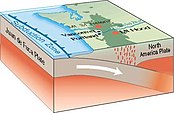Wikipedia:Today's featured article/requests/Boring Lava Field
Boring Lava Field
[edit]- This is the archived discussion of the TFAR nomination for the article below. Subsequent comments should be made on the appropriate discussion page (such as Wikipedia talk:Today's featured article/requests). Please do not modify this page.
The result was: scheduled for Wikipedia:Today's featured article/April 1, 2023. by Jimfbleak - talk to me? 14:39, 9 March 2023 (UTC)

The Boring Lava Field is a Plio-Pleistocene volcanic field with cinder cones, small shield volcanoes, and lava flows in the northern Willamette Valley of the U.S. states of Oregon and southwest Washington. The zone became active about 2.7 million years ago, with long periods of eruptive activity interspersed with quiescence. Its last eruptions took place about 57,000 years ago; individual volcanic vents are considered extinct, but the field itself is not. The volcanic field covers an area of about 1,500 square miles (3,900 km2), and has a total volume of 2.4 cubic miles (10 km3). The highest elevation of the field is at Larch Mountain, which reaches a height of 4,055 feet (1,236 m). The Portland metropolitan area, including suburbs, is one of the few places in the continental United States to have extinct volcanoes within a city's limits. The probability of future eruptions affecting the Portland–Vancouver metropolitan area is very low. (Full article...)
- Most recent similar article(s): Cerro Blanco (volcano)
- Main editors: Ceranthor
- Promoted: December 12, 2022
- Reasons for nomination: Given its name, some suggested this might be a good article for TFA on April 1 this year. Open to further discussion about making the blurb more whimsical if so! Thanks to Gog the Mild for writing this blurb.
- Support as nominator. ceranthor 23:20, 15 February 2023 (UTC)
- Support. Gog the Mild (talk) 17:00, 16 February 2023 (UTC)
- Support. Vida0007 (talk) 12:49, 21 February 2023 (UTC)
- Support this is the best option so far. Z1720 (talk) 19:33, 21 February 2023 (UTC)
